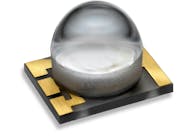Top tips for designing optimized technical sheet material parts
Top tips for designing optimized technical sheet material parts
Sheet materials for use in electronic products and equipment are available with a wide range of properties to perform different functions and are therefore an important resource for electromechanical designers working in a wide range of sectors and serving a diverse array of end markets.
Technical sheet materials may perform roles such as an environmental gasket, electrical insulator or conductor, or a light diffuser on solid state (LED) applications or combinations of several.
The traditional approach
Traditionally the manufacture of custom shapes in sheet materials has been achieved by a die cutting process using single or multi-part tools depending on the volume throughput required by the customer’s application. While investing in a multi-part tool for volume production and when the design of the part is fixed is often completely appropriate and cost-effective approach, for smaller volumes, or when the design is still in its development stages, committing to costly tooling makes little sense and can incur unwelcome costs and time delays to a project. In response to this less than ideal situation, Materials Direct has developed an innovative tool-free process for producing custom parts in a wide array of technical sheet materials from many of the world’s leading suppliers. This saves time and money, and to simplify the whole process further, Materials Direct with its breadth of choice, can provide a true ‘one-stop shop.’
For designers tasked with developing solutions for products, it is helpful to know just what can and cannot be achieved when designing custom parts. Whilst the design considerations for sheet material are essentially two dimensional – the third dimension simply being the selection of a material of appropriate thickness – there are some important ‘dos’ and don’ts’ that should be followed in order to achieve part designs that perform as required, are manufacturable, support ease of assembly and are cost-effective.
Here is an overview of some of the top tips:
- 1. Tolerancing
Technical sheet materials with a fabric base can’t have, and don’t need, the same tolerances as precision metal components. Typical achievable tolerances do vary depending on the nature (hardness, thickness) of the sheet material, but if designers can settle on around +/- 0.3mm or greater then it can be quicker, easier and more cost-effective to make parts using Materials Direct’s tool-free process.
Whilst tighter tolerances can be achieved, this level aligns with what is often specified for die-cutting techniques anyway. Good general tolerancing practise, also applies and designers should be careful to avoid tolerance stack-up where there are multiple cut-outs or holes in the part required. Specifying dimensions from a single datum as opposed to from one detail to the next and so on is the way to avoid tolerance stack-up issues that may manifest in misalignment of fixing holes for example.
- 2. Design for orientation / ease of assembly
Not so much for prototyping, but in readiness for volume production it is a good idea to consider features in the profile of the sheet material part that will aid assembly in some way. For example, a small protruding tab included in the design can help those working on the production assembly line fit the part with the correct orientation where it may not be obvious or there is potential for error. In addition, a tab can we a way of visually confirming that a gasket or other sheet interface part is present without needing to take the assembly apart to check. Oversizing the material is another way of visually checking the presence of an interface pad or gasket. - 3. Combining several parts in one
In an application where multiple pieces of interface material might be used, it is worth considering if a design that combines previously separate parts into a single piece might be worthwhile. Although the overall material cost may be more, this may be offset in the time and assembly savings and simplification given as a result. If the individual parts were very small and difficult to handle, then a larger single part may ease assembly and even lend the product to consideration for an automated process once in volume production. - 4. Design for robustness and long life
The careful selection of the most appropriate material for a task is the key to a solution that has longevity and reliability. Whilst a lower cost material may do the job adequately at the outset, issues may develop over the life of an assembly or product with regard to physical, environmental or perhaps, depending on the material, electrical problems.
The impact of product failure, both in terms of cost and reputation is high, so close attention to correct material selection is key. Materials Direct not only offers an extensive choice of technical sheet materials from leading suppliers – it can also provide advice based on many years of applications experience in sectors ranging from lighting to aerospace and automotive to white and brown goods.
Summary
Precision cut sheet materials produced without tooling offer great flexibility and opportunities for designers to engineer their end products more quickly, with the freedom to modify part design without fear of incurring tooling costs and associated delays. Following some of the simple design tips provided here and making use of the in-house expertise of companies like Materials Direct can help optimise part design in addition to the process optimisation enjoyed by going ‘tool-free.’
Ends
For further information please contact:
James Stratford
Materials Direct
Unit 16, Walker Avenue, Wolverton Mill, Milton Keynes, MK12 5TW
T +44 (0)1908 22 22 11
m+ 44 (0)7814 92 69 13





